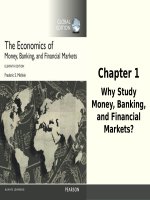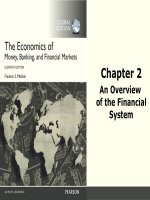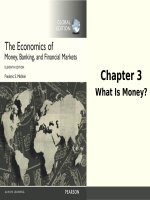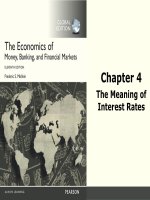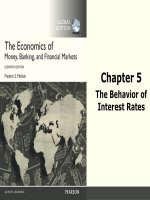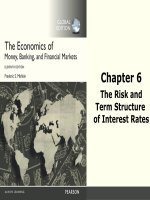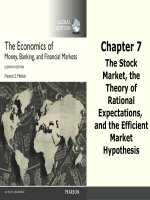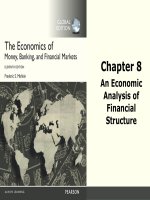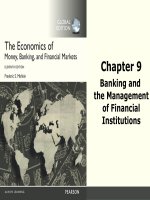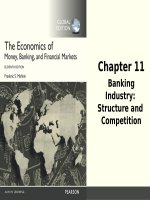The economics of money, banking, and financial institutions (11th edition) by f s mishkin ch3
Bạn đang xem bản rút gọn của tài liệu. Xem và tải ngay bản đầy đủ của tài liệu tại đây (371.07 KB, 18 trang )
Chapter 3
What Is Money?
20-1
© 2016 Pearson Education Ltd. All rights reserved.
Preview
• In this chapter, we develop precise
definitions by exploring the functions of
money, looking at why and how it promotes
economic efficiency, tracing how its forms
have evolved over time, and examining how
money is currently measured.
1-2
© 2016 Pearson Education Ltd. All rights reserved.
Learning Objectives
•
•
•
•
1-3
Describe what money is
List and summarize the functions of money
Identify different types of payment systems
Compare and contrast the M1 and M2
money supplies
© 2016 Pearson Education Ltd. All rights reserved.
Meaning of Money
• Money (or the “money supply”): anything
that is generally accepted as payment for
goods or services or in the repayment of
debts.
• A rather broad definition
1-4
© 2016 Pearson Education Ltd. All rights reserved.
Meaning of Money
• Money (a stock concept) is different from:
– Wealth: the total collection of pieces of property
that serve to store value
– Income: flow of earnings per unit of time
(a flow concept)
1-5
© 2016 Pearson Education Ltd. All rights reserved.
Functions of Money
• Medium of Exchange:
– Eliminates the trouble of finding a double
coincidence of needs (reduces transaction costs)
– Promotes specialization
• A medium of exchange must:
–
–
–
–
–
1-6
be easily standardized
be widely accepted
be divisible
be easy to carry
not deteriorate quickly
© 2016 Pearson Education Ltd. All rights reserved.
Functions of Money
• Unit of Account:
– Used to measure value in the economy
– Reduces transaction costs
• Store of Value:
– Used to save purchasing power over time
– Other assets also serve this function.
– Money is the most liquid of all assets but loses
value during inflation.
1-7
© 2016 Pearson Education Ltd. All rights reserved.
Evolution of the Payments System
• Commodity Money: valuable, easily
standardized and divisible commodities (e.g.
precious metals, cigarettes)
• Fiat Money: paper money decreed by
governments as legal tender
1-8
© 2016 Pearson Education Ltd. All rights reserved.
Evolution of the Payments System
• Checks: an instruction to your bank to
transfer money from your account
• Electronic Payment (e.g. online bill pay).
• E-Money (electronic money):
– Debit card
– Stored-value card (smart card)
– E-cash
1-9
© 2016 Pearson Education Ltd. All rights reserved.
Are We Headed for a Cashless
Society?
• Predictions of a cashless society have been
around for decades, but they have not come
to fruition.
• Although e-money might be more
convenient and efficient than a payments
system based on paper, several factors work
against the disappearance of the paper
system.
• However, the use of e-money will likely still
increase in the future.
1-10
© 2016 Pearson Education Ltd. All rights reserved.
Will Bitcoin Become the Money of
the Future?
• Bitcoin is type of electronic money created
in 2009.
• By “mining,” Bitcoin is created by
decentralized users when they use their
computing power to verify and process
transactions.
• Although Bitcoin functions as a medium of
exchange it is unlikely to become the money
of the future because it performs less well as
a unit of account and a store of value.
1-11
© 2016 Pearson Education Ltd. All rights reserved.
Measuring Money
• How do we measure money? Which
particular assets can be called “money”?
• Construct monetary aggregates using the
concept of liquidity:
– M1 (most liquid assets) = currency + traveler’s
checks + demand deposits + other checkable
deposits
1-12
© 2016 Pearson Education Ltd. All rights reserved.
Measuring Money
• M2 (adds to M1 other assets that are not so
liquid) = M1 + small denomination time
deposits + savings deposits and money
market deposit accounts + money market
mutual fund shares
1-13
© 2016 Pearson Education Ltd. All rights reserved.
The Federal Reserve’s Monetary
Aggregates
1-14
© 2016 Pearson Education Ltd. All rights reserved.
The Federal Reserve’s Monetary
Aggregates
M1 (4)
M2 (4+3)
Currency
Small Den. Dep.
Traveler’s
Checks
Savings and MM
Demand
Deposits
Money Market
Mutual Funds
Shares
Other Check.
Dep
M3
(4+3+4)
1-15
© 2016 Pearson Education Ltd. All rights reserved.
The Federal Reserve’s Monetary
Aggregates
• M1 versus M2: Does it matter which
measure of money is considered?
• M1 and M2 can move in different directions
in the short run (see figure).
• Conclusion: the choice of monetary
aggregate is important for policymakers.
1-16
© 2016 Pearson Education Ltd. All rights reserved.
Where Are All the U.S. Dollars?
• The more than $4,000 of U.S. currency held
per person in the United States is a
surprisingly large number.
• Where are all these dollars and who is
holding them?
– Criminals
– Foreigners
1-17
© 2016 Pearson Education Ltd. All rights reserved.
Figure 1 Growth Rates of the M1 and M2
Aggregates, 1960–2014
Source: Federal Reserve Bank of St. Louis, FRED database: />
1-18
© 2016 Pearson Education Ltd. All rights reserved.
